3D Printing News Briefs, January 20, 2024: FDM, LPBF, Underwater 3D Printer, Racing, & More
We’re starting off with a process certification in today’s 3D Printing News Briefs, and then moving on to research about solute trapping, laser powder bed fusion, and then moving on to a partnership that will help advance 3D printed healthcare solutions. We’ll end things with an underwater 3D printer and Formula Student racing.
Stratasys Receives NOCTI Validation for FDM Process Certification
According to the Manufacturing Leadership Council (MLC), additive manufacturing makes up about 1% of manufacturing today, and the gap in skilled AM workers is expected to jump to 2.1 million unfilled openings by 2030. Stratasys announced that the National Occupational Competency Testing Institute (NOCTI)—the nation’s leader in career and technical education—has validated its first Fused Deposition Modeling (FDM) Process Certification, which is a major step towards improving education and building skilled workforces in the AM field. This certification means that students and professionals looking for a career in AM will have the best possible training for the field. Certification participants will receive industry-endorsed skills, and schools that get FDM certification can apply more easily for funding opportunities to create even more learning opportunities. As part of the partnership, NOCTI is also introducing a general FDM certification exam.
“Stratasys is committed to advancing the additive manufacturing industry by not only providing cutting-edge technology but also by ensuring that students and professionals receive industry-recognized skills. Our collaboration with NOCTI signifies a profound commitment to education and workforce development, enabling individuals to thrive in the world of 3D printing,” said Rich Garrity, Chief Industrial Business Unit Officer, Stratasys.
Solute Transport & Solidification Mechanisms in AM
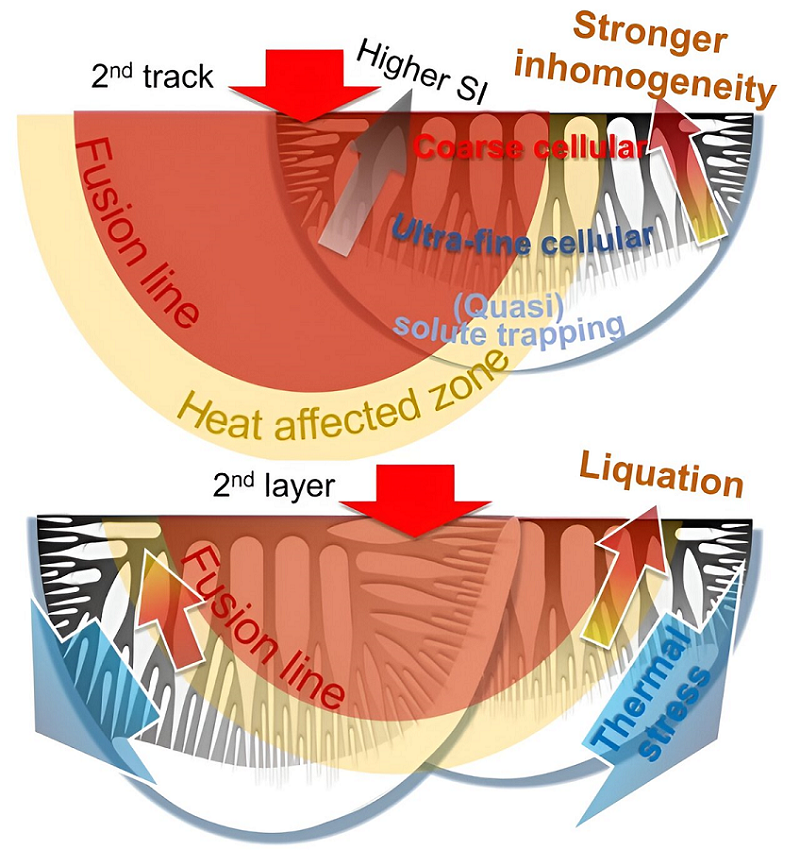
The effect of solute trapping on the solidification behaviors and crack susceptibility. Schematic diagram of the characteristics of microstructure and segregation pattern. Image credit: Nature Communications (2023). DOI: 10.1038/s41467-023-43563-x
A phenomenon in AM called solute trapping takes place when solute elements (parts of a substance dissolved in a solution) are concentrated in particular regions of a solidification front, which can lead to unstable microstructures and defects like cracks and porosities. Researchers from Queen Mary University of London, Shanghai Jiao Tong University, China’s Centre of Excellence, and the University of Leicester created a computational model to show how solute trapping takes place during the rapid solidification process in AM, and their study offers new insights into solute transport. They used their model to investigate the solute transport that happens during the technology’s rapid and repeated thermal cycles, and found that it’s promoted by melt convection, which dilutes the partitioned solute at the solidification front. The researchers believe their findings could help decrease crack susceptibility in 3D printed parts by speeding up solidification, and develop superalloys with better printability.
“Solute trapping is like adding a secret ingredient to a recipe. By understanding how solute trapping works, we can develop new materials and processes that can lead to stronger, more reliable, and more complex 3D printed components,” explained Dr. Chinnapat Panwisawas, corresponding author on the study and Senior Lecturer in Materials and Solid Mechanics at Queen Mary University of London.
EPFL Researchers Settle Long-Running LPBF 3D Printing Dispute
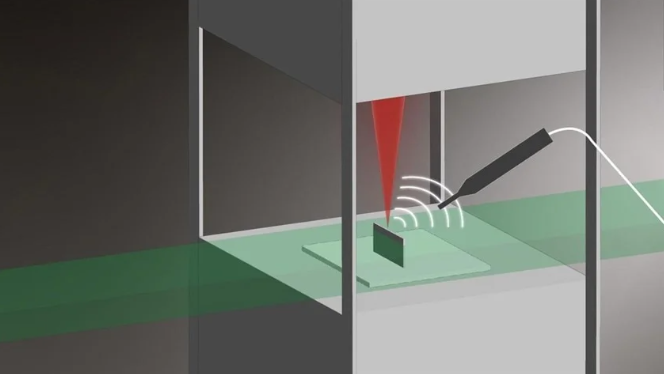
A graphic representation of the experimental setup for listening for 3D printing defects. Image Credit: EPFL/Titouan Veuillet
Speaking of AM defects, in a new study, a team of researchers from EPFL School of Engineering’s Laboratory of Thermomechanical Metallurgy (LMTM), the Paul Scherrer Institute (PSI), and the Swiss Federal Laboratories for Materials Science and Technology (Empa), have finally settled a long-time dispute over laser powder bed fusion 3D printing—using a novel technique that combines X-ray imaging and acoustic monitoring to detect defects and flaws. Typical monitoring techniques, like machine learning and thermal imaging, often don’t see the defects, or don’t understand them, and acoustic monitoring—comparing the sounds produced by the printer when a print is perfect vs. when it has anomalies—was thought to be unreliable. But the researchers and their experimental design, which combines synchrotron X-ray imaging with acoustic emission measurements, have proven this theory incorrect. The approach offers deeper insights into the physics of melting regimes, and is also a more affordable way to monitor printing.
“There’s been an ongoing debate regarding the viability and effectiveness of acoustic monitoring for laser-based additive manufacturing,” said Roland Logé, Professor and Head, Laboratory of Thermomechanical Metallurgy, EPFL. “Our research not only confirms its relevance but also underscores its advantage over traditional methods.”
NTU Singapore & SGH Establish Joint R&D Lab for Medical 3D Printing
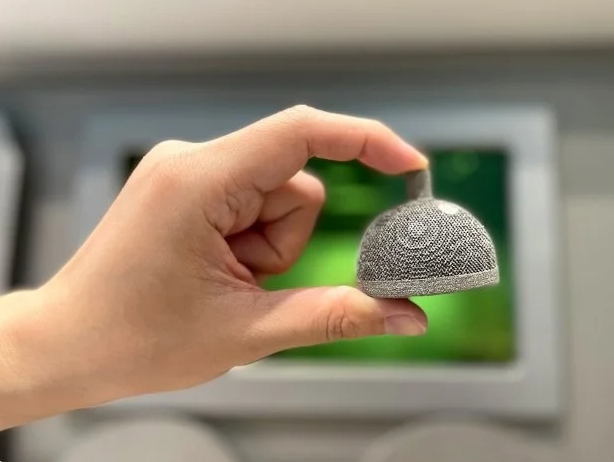
NTU’s Singapore Centre for 3D Printing (SC3DP) is able to print orthopedic implants made from titanium-tantalum that can be customized to a patient’s unique anatomy, reducing the amount of surgical time in hospital. Image Credit: NTU Singapore
A partnership between Singapore General Hospital (SGH) and Nanyang Technological University, Singapore (NTU Singapore) will establish a joint research and development laboratory to advance medical 3D printing applications, such as personalized devices and implants. The facilities and combined expertise of NTU’s Singapore Centre for 3D Printing (SC3DP) and the 3D Printing Centre at SGH will be used to research and create relevant technologies for clinical applications at the point-of-care. The Joint R&D Lab will focus on four areas of research, starting with developing modeling and AM approaches for prosthetics and orthotics; one of the main goals is creating design standards and specifications for these devices. The second is bioprinting for regenerative medicine, and the third is 3D printed implants at point-of-care out of both metal and PEEK. The final area is examining and improving the state of AM for the healthcare industry by finding and creating possible clinical applications, like flexible electronics and food 3D printing.
“Through the combined medical expertise from SGH and the extensive knowledge of additive manufacturing and advanced materials of NTU’s faculty, our collaboration aims to forge innovative solutions in the development of personalized prosthetic and orthotic devices and explore new pathways for regenerative medicine,” said Professor Lam Khin Yong, Vice President (Industry) of NTU Singapore. “This collaboration also greatly benefits the next generation of clinicians, academics, and engineers, through its upcoming shared educational programs, shared resources, and joint initiatives. NTU and SGH are committed to nurturing new talent that possesses the skills and knowledge needed to navigate the ever-evolving medical landscape.”
CPSdrone Makers Build an Underwater 3D Printer
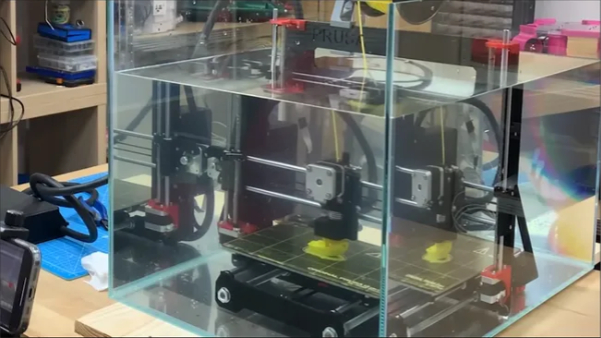
A screen capture of CPSdrone’s underwater 3D printer during a printing operation. (Image credit: CPSdrone on YouTube)
Between 2018 and 2022, the makers at CPSdrone have built about 15 prototypes of underwater drones, and now want to teach others what they’ve learned. One of their recent projects wasn’t an underwater drone, but a 3D printer that could operate underwater! There are some benefits to underwater 3D printing, including no longer needing cooling fans to dissipate heat, which could result in higher-quality prints, and an underwater 3D printer could be useful in industry applications such as repairing seabed pipelines. To prepare it for underwater use, the CPSdrone team made many modifications to their custom printer—which looks like it’s based on a Prusa i3—including keeping the display and power supply out of the water, waterproofing several parts with various epoxies to prevent short-circuiting, and swapping some of the metal parts, which would quickly corrode, for plastic ones. The printer worked great during testing in an aquarium tank, but began to stutter due to severe rusting during testing in a pool.
“The biggest takeaway is that 3D printing underwater does work (though you’d need to significantly modify even the best 3D printers), but doesn’t fully live up to the hype of the video thumbnail (depicting a print inside a swimming pool). Unfortunately, that feat is actually outside of the range of what CPSdrone could achieve with this project, despite their efforts,” Christopher Harper wrote for Tom’s Hardware.
You can watch the 17-minute video breakdown of this project here:
Munich Formula Student Racing Team Uses Sintratec for Prototyping
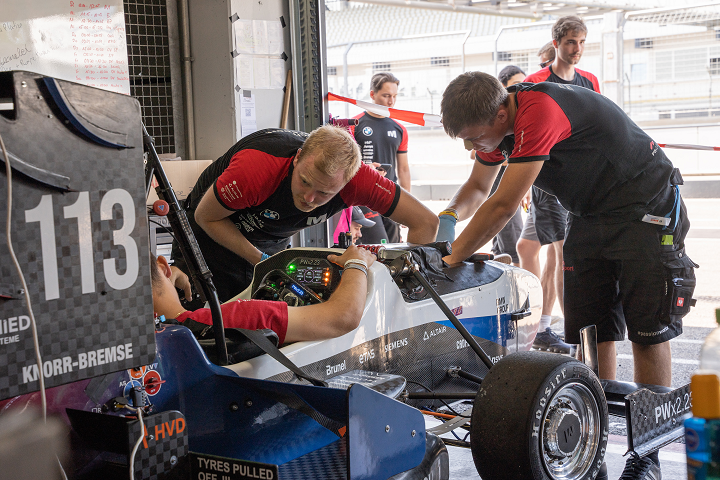
The munichmotorsport team busy in the pits preparing the car for the dynamic disciplines. Image credit: Sintratec
Every year, munichmotorsport, the 40-member interdisciplinary SAE Racing Team of the Munich University of Applied Sciences, designs and builds its own racecar for the Formula Student racing series. About 100 teams compete on the track, and in other disciplines like marketing and business administration, in one of the world’s biggest engineering competitions. This team, like many others, uses 3D printing to make racecar parts, and munichmotorsport worked with Sintratec for rapid prototyping of these parts using its SLS technology. Engineering student Niklas Rösler was in charge of the electric racecar’s high-voltage system this year, and he needed to guarantee cooling of the system, as well as safe storage for the battery cells. To regulate the airflow and cool the system, he 3D printed spacers out of PA12 on the Sintratec S3, and used the same system and material to print housings that stabilized individual battery cells in the rear of racecar.
“SLS 3D printing is the most suitable prototyping technology for our racing team. We can use it in almost every situation around the car,” said Rösler.
“The PA12 material from Sintratec covers most areas of application in the race car. It offers the best mechanical properties for our purposes and high dielectric strength.”
While there were some technical issues initially, munichmotorsport overcame them and placed 20th out of 71 participating teams in its class.
Subscribe to Our Email Newsletter
Stay up-to-date on all the latest news from the 3D printing industry and receive information and offers from third party vendors.
Print Services
You May Also Like
RAPID 2025: Stratasys & trinckle Announce Strategic Software Partnership
News continues to flood in from last week’s RAPID+TCT 2025, including a new partnership between AM market leader Stratasys and Berlin-based software company trinckle. By automating important steps in fixture...
RAPID TCT 2025: Spring in the Paris of the Midwest
I’m going to go out on a limb here and say that whomever coined the phrase Detroit: Paris of the Midwest, had not spent a lot of time in Paris...
3D Printing Financials: 3D Systems Looks to Bounce Back in 2025
After a challenging year for the industry, 3D Systems (NYSE: DDD) ended 2024 with results pointing to a reset, laying the groundwork for future profitability. The company didn’t post strong...
Printing Money Episode 27: Q4 2024 Public 3D Printing Earnings Review with Troy Jensen, Cantor Fitzgerald
Q2 2025 has already begun, but public markets reporting has only just finished with Q4 2024. To tie a bow on Q4 2024, we are thankful to have Troy Jensen...


























